When it comes to Filipino cuisine, few dishes match the comforting richness and tantalizing flavors of Pork Mechado. This beloved dish can be enjoyed during family gatherings, celebrations, and everyday meals. With its blend of Spanish and Filipino influences, Pork Mechado offers a symphony of tastes that captivate the palate.
And if you like the flavors of mechado and want to try my recipes for Beef Mechado and Chicken Mechado, you're in for a treat! These dishes pair well with steamed rice (of course), or try this Garlic Fried Rice and make it a complete meal!
Jump to:
The Origins of Pork Mechado
Derived from the Spanish word mecha (meaning to insert), Pork Mechado has its roots in Spain's culinary heritage. It was introduced to the Philippines during the Spanish colonial period and evolved over time, acquiring local touches and adaptations.
Ingredients and Substitutions
The key components include pork, tomatoes, soy sauce, bay leaves, and a hint of tanginess from calamansi or lemon.

- Protein: I used pork belly. However, you can use different cuts, like pork shoulder or pork butt. You can also substitute beef, chicken, or even tofu.
- Aromatics: Garlic and Medium Onion.
- Flavorings (herbs and spices): Soy sauce, lemon, or calamansi juice. Bay leaves, salt, and whole black peppercorns.
- Vegetables: Carrots, potatoes, fresh tomatoes, green bell peppers, and red bell peppers. You can also add or substitute green peas if you wish.
- Liquid: I used chicken broth and 8 oz tomato sauce. You can substitute beef or vegetable broth or simply use water and/or add beef cubes or chicken bouillon cubes.
- Cooking oil: I prefer olive oil, but you can use oil of your choice.
Please refer to the recipe card for exact measurements.
Instructions

Step 1: Make a Sofrito: Heat oil in a pan over medium heat. For two minutes, saute garlic, onion, and tomatoes until fragrant and caramelized.

Step 2: Add Pork: In the same pan, add the pork belly and stir until the pork is no longer pink and slightly light brown.
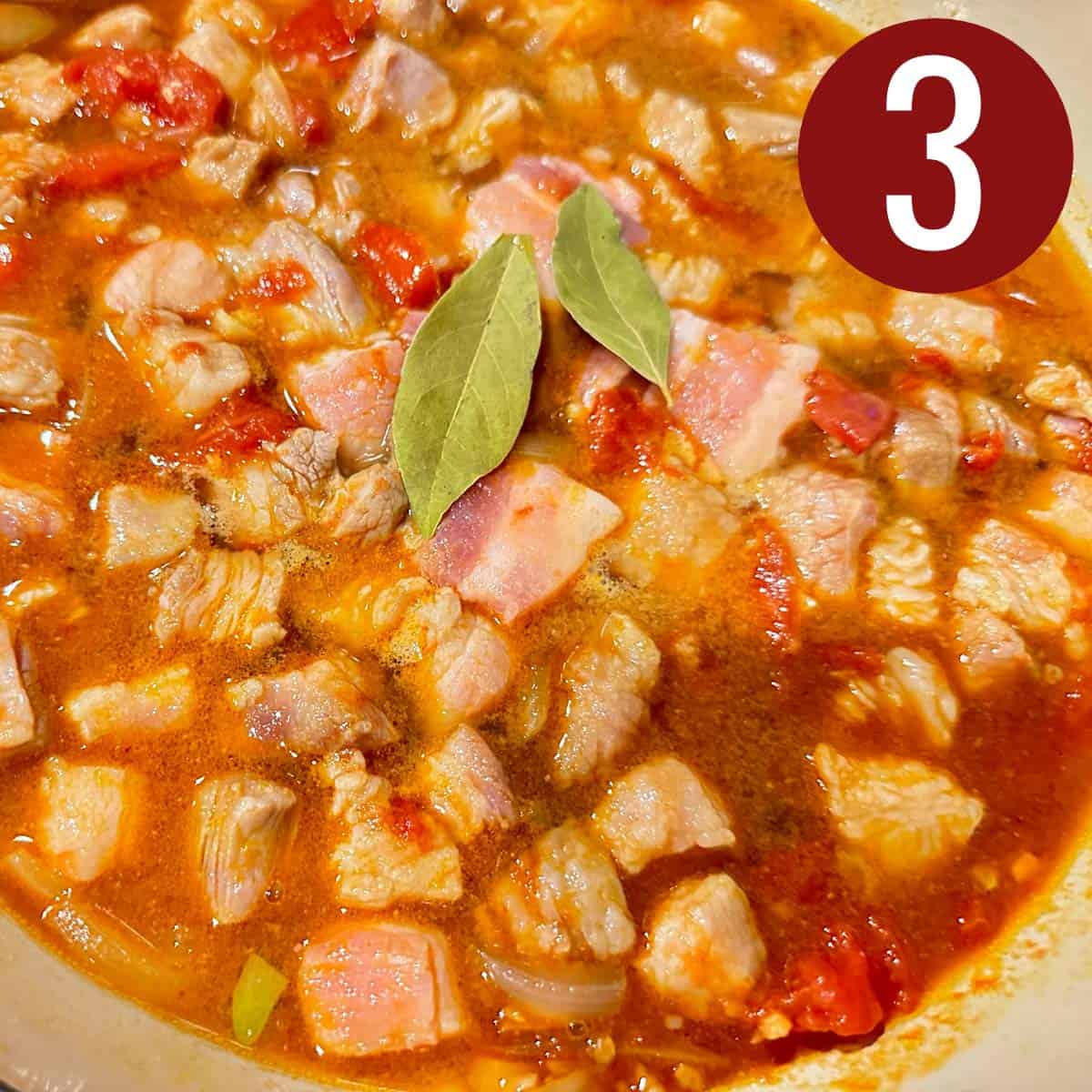
Step 3: Combine and Simmer: Add the chicken broth, tomato sauce, juice of one lemon (or calamansi juice if using), bay leaves, sugar, salt, and whole black peppercorns into the pan. Bring it to a boil, lower the heat, and let it simmer until the pork is tender (approximately 45 minutes to an hour).

Step 4: Add Vegetables: Once the pork is tender, add the potatoes, carrots, and red and green bell pepper. Let it cook until the vegetables are fork-tender and the sauce thickens.
Season and Serve: Season with salt and black pepper to taste. Remove the bay leaves before serving. Serve with cooked white rice.
Tips for a Perfect Mechado
- Meat Choice: Opt for pork shoulder or pork belly for the best texture and flavor.
- Marination: Marinating the pork cube in soy sauce and calamansi or lemon juice for an hour before cooking can enhance its taste.
- Slow Cooking: Simmering the dish on low heat allows the flavors to meld beautifully, resulting in a more delicious outcome.
Serving Suggestions
Pork Mechado is traditionally served with steamed white rice, allowing the savory sauce to meld with the grains for a delightful dining experience. For a complete meal, pair it with a side of sautéed vegetables or a fresh salad to balance the richness of the dish.
Storage for Leftovers
Properly storing leftover Pork Mechado is essential to maintain its flavor and quality. Here are some steps to ensure your leftovers stay fresh:
Refrigeration:
- Cooling Down: Let the Pork Mechado cool to room temperature before refrigerating. Leaving it out for too long can lead to bacterial growth.
- Airtight Containers: Transfer the leftovers into airtight containers or resealable bags. Make sure to remove as much air as possible to preserve freshness.
- Labeling and Date: Label the containers when you cooked the Pork Mechado. This helps in tracking its freshness.
- Refrigeration Time: Store the leftovers in the refrigerator within two hours of cooking. Consume within 3-4 days for the best quality.
Freezing (for longer storage):
- Cool Completely: Like refrigeration, ensure the Pork Mechado cools down entirely before freezing.
- Portioning: Divide the leftovers into smaller portions suitable for individual meals. This allows you to thaw only what you need.
- Freezer-Safe Containers: Use freezer-safe containers or heavy-duty freezer bags. Remove excess air and seal tightly to prevent freezer burn.
- Labeling: Label the containers with the date and contents for easy identification.
- Freezer Duration: Pork Mechado can be kept in the freezer for 2-3 months without compromising taste and quality.
Reheating:
When reheating Pork Mechado, follow these steps for the best results:
- Thawing: If frozen, thaw the Pork Mechado overnight in the refrigerator before reheating.
- Stovetop: Reheat gently on the stovetop in a saucepan or skillet over low to medium heat. Add a splash of water or broth to prevent drying out.
- Microwave: If using a microwave, cover the dish loosely and reheat in short intervals, stirring occasionally to ensure even heating.
Safety Note:
Always reheat leftovers to an internal temperature of 165°F (74°C) to kill any bacteria that might have developed during storage.
Following these storage guidelines and reheating tips, you can enjoy your flavorful Pork Mechado even after it’s been refrigerated or frozen, ensuring every bite tastes just as delicious as when it was freshly made! The beauty of this dish is it tastes even better the next day! So hurray and enjoy your leftovers!!
FAQ
While the ingredients have some similarities, the difference is in how the dish is prepared. Afritada is derived from the Spanish word 'fritada,' which means to fry, while Mechado is also from the Spanish word 'mecha,' meaning to insert a piece of lard into the meat to help tenderize it.
The name mechado comes from the Spanish term mecha, meaning "wick," due to how the larded beef resembles the shape of a candle.
Find what you're Looking For:
Browse full recipe index →
Related Recipes
Love Mechado? Try these other recipes:
New Recipes
New recipes we don't want you to miss!
📖 Recipe

Ingredients
- 2 tablespoon Olive Oil
- 3 cloves Garlic minced
- 1 medium Onion sliced or quartered
- 1 medium Tomato sliced or quartered
- 1 ½ pound Pork Belly 1" cubed
- 3 tablespoon Soy Sauce
- 1 cup Chicken Broth
- 8 ounce Tomato Sauce
- ½ fresh Lemon Juice
- 2 Bay Leaves
- 2 teaspoon Sugar
- 2 teaspoon Salt or to taste
- 1 teaspoon Whole Black Peppercorns
- 2 medium Potatoes diced
- 2 medium Carrots sliced
- 1 each Green and Red Bell Peppers sliced
Instructions
- Heat oil in a pan over medium heat. For two minutes, saute garlic, onion, and tomatoes until fragrant and caramelized.2 tablespoon Olive Oil, 3 cloves Garlic, 1 medium Onion, 1 medium Tomato
- In the same pan, add the pork belly and soy sauce then sauté until the pork is no longer pink and slightly light brown.1 ½ pound Pork Belly, 3 tablespoon Soy Sauce
- Add the chicken broth, tomato sauce, juice of one lemon (or calamansi juice if using), bay leaves, sugar, salt, and whole black peppercorns into the pan. Bring it to a boil, lower the heat, and let it simmer until the pork is tender (approximately 45 minutes to an hour).1 cup Chicken Broth, 8 ounce Tomato Sauce, ½ fresh Lemon Juice, 2 Bay Leaves, 2 teaspoon Sugar, 2 teaspoon Salt, 1 teaspoon Whole Black Peppercorns
- Once the pork is tender, add the potatoes, carrots, and red and green bell pepper. Let it cook until the vegetables are fork-tender and the sauce thickens.2 medium Potatoes, 2 medium Carrots, 1 each Green and Red Bell Peppers
Notes
- If pork belly is not your thing, use different cuts of pork like pork shoulder or pork butt. You can also use different proteins like beef, chicken, or tofu.
- If you have calamansi juice, use that in place of lemon. Calamansi is the more traditional Filipino ingredient in making Mechado.
- You can add green peas to Mechado. It adds a hint of sweetness to the dish. My son doesn't care for peas, so I omit them. 🙂
- If using chicken bouillon cubes, you can cut back on the salt.
- Always toss the bay leaves after cooking. Leaving the bay leaves in the dish for a prolonged time can impart a very overpowering flavor to the dish.
- Serve Pork Mechado with steamed white rice.
















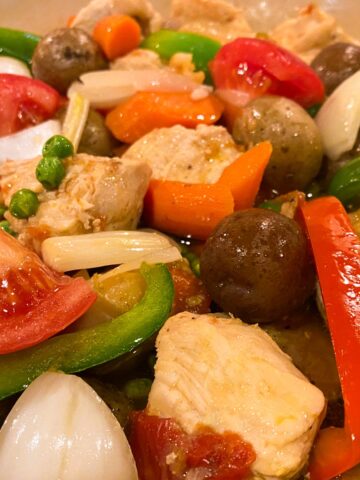

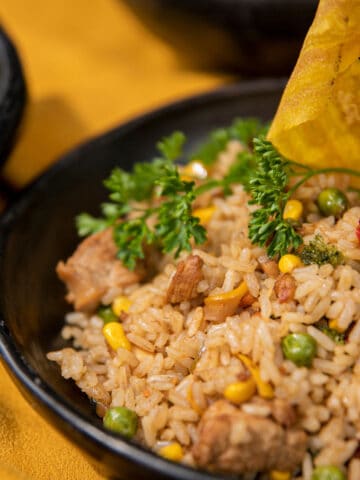

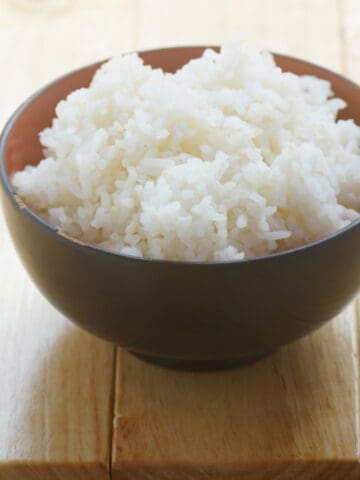

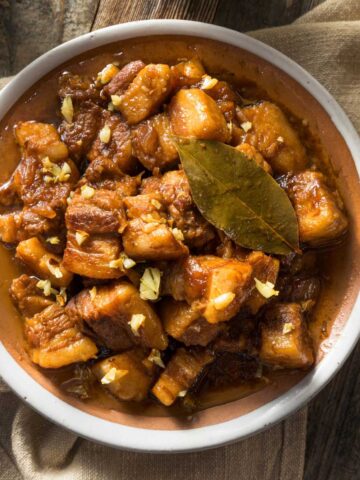



Comments
No Comments